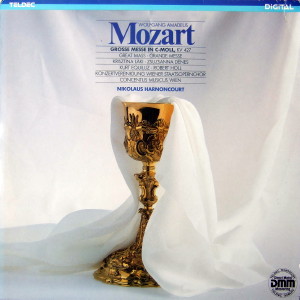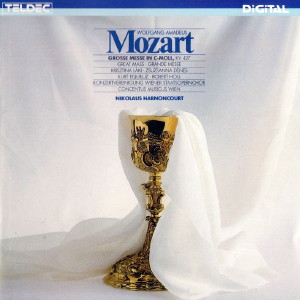 |
1 LP -
6.43120 AZ - (p) 1985
|
 |
| 1 CD -
8.43120 ZK - (p) 1985 |
|
| Wolfgang
Amadeus Mozart (1756-1791) |
|
|
|
|
|
|
|
Missa in c, KV 427 (417a)
|
|
55' 47" |
|
| Mit Ergänzungen *
(bzw. Korrekturen der Chorstimmen **)
von Franz Beyer |
|
|
|
|
|
|
|
| - Kyrie: Andante
moderato (Chor, Sopran Solo) |
6' 23" |
|
A1 |
| - Gloria:
Allegro vivace (Chor) |
2' 26" |
|
A2 |
| - Laudamus
te: Allegro aperto (Sopran Solo) |
4' 55" |
|
A3 |
| - Gratias: Adagio (Chor) |
1' 01" |
|
A4 |
| - Domine: Allegro
moderato (Sopran I, Sopran II Soli) |
2' 49" |
|
A5 |
| - Qui tollis: Largo
(Chor I, Chor II) |
6' 04" |
|
A6 |
| - Quoniam: Allegro
(Sopran I, Sopran II, Tenor Soli) |
4' 29" |
|
A7 |
| - Jesu Christe: Adagio
(Chor) |
0' 35" |
|
B1 |
- Cum Sancto Spiritu:
(alla breve) (Chor)
|
4' 22" |
|
B2 |
| - Credo: Allegro
maestoso (Chor) * |
3' 29" |
|
B3 |
| - Et incarnatus est:
(Andante) (Sopran Solo) * |
8' 15" |
|
B4 |
| - Sanctus: Largo
(Chor I, Chor II) ** |
1' 53" |
|
B5 |
| - Hosanna:
Allegro comodo (Chor I, Chor II) ** |
2' 08" |
|
B6 |
| - Benedictus:
Allegro comodo (Sopran I, Sopran II,
Tenor, Baß Soli) |
6' 33" |
|
B7 |
|
|
|
|
| Krisztina Láki,
Sopran |
|
| Zsuzsanna Dénes,
Sopran |
|
| Kurt
Equiluz, Tenor |
|
| Robert
Holl, Baß |
|
|
|
| Konzertvereinigung
Wiener Staatsopernchor / Walter Hagen-Groll,
Leitung |
|
CONCENTUS
MUSICUS WIEN (mit
Originalinstrumenten)
|
|
|
|
| Nikolaus
Harnoncourt, Leitung |
|
|
Luogo
e data di registrazione
|
Grosses
Musikvereinssaal, Vienna (Austria) - 1984
|
|
Registrazione
live / studio
|
| studio |
Producer
/ Engineer
|
-
|
Prima Edizione CD
|
| Teldec
- 8.43120 ZK - (1 cd) - 55' 47" - (p)
1985 - DDD |
Prima
Edizione LP
|
Teldec - 6.43120
AZ - (1 lp) - 55'
47"
- (p) 1985 - Digital
|
|
| Notes |
The
Masses and Vespers which Mozart wrote
while he was at Salzburg can best be
described as his daily bread. Splendid
though some of them were, his church
music of that period kept, by and large,
lo well-trodden paths. By comparison
with these works the incomplete Mass in
C minor K. 427 is a class of its own.
Mozart’s vow to compose a Mass after his
marriage to Constanze Weber and to
perform it when he presented his bride
in Salzburg was no mere lip service.
When, at the end of July 1783, he and
his young wife embarked on their
oft-postponed journey to Salzburg, he
probably carried the score up to and
including the “Et incarnatus est” in his
luggage. he may even have been working
on the “Sanctus” and “Benedictus“ in
Salzburg, possibly using sketches made
in Vienna, since, according to the
introduction to the Mass K. 427 in the
New Mozart Edition by Monika Holl and
Karl-Heinz Köhler and contrary to
statements in older books on Mozart, the
Mass may well not have had its first
performance until October. At least
there is mention in the diary of
Mozart’s sister Nannerl ofa rehearsal
for a Mass on 23rd October in the
“capelHaus” and finally of a performance
on the Sunday following, the 26th
October, in the Benedictine collegiate
church of St. Peter, with “all the court
music" taking part. There is good reason
to assume that this was the Mass in C
minor, K. 427.
Since St. Peter’s (which, incidentally,
did not come under the jurisdiction of
the Archbishop of Salzburg, Mozart’s
former employer) had at its disposal no
more than some ten singers and as many
instrumentalists, both choir and
orchestra had to be augmented by
“outside” forces. According to Nannerl’s
report, her sister-inlaw Constanze sang
both soprano solo parts at this first
performance. Close friends of the
family, one of two sopranos at the Court
(either Francesco Ceccarelli or
Michelangelo Bologna) and the tenor
Giuseppe Tomaselli probably took the
other two solo parts.
The first performance in Salzburg is
shrouded in mystery. It has still not
been established whether Mozart filled
in the missing parts in the “Credo” and
the whole “Agnus Dei” by making use of
appropriate movements from earlier
masses. Not even the new Mozart research
has been able to shed any light on this
problem. But it is certainly worth
noting that (in view of the conditions
in Salzburg) Mozart dispensed with
clarinets, even though he used a large
orchestra in which three trombones, who
played colla parte with the chorus
altos, tenors and basses as was then
customary in Salzburg, were occasionelly
given independent parts to play as well.
With its comparatively rich scoring, its
unusual dimensions and its expressive
breadth and depth, the Mass in C minor
is in an entirely different category
from Mozart’s other masses. In the
“Credo” and “Gratias” the customary
four-part chorus is expanded to five
parts, and the “Qui tollis" is even laid
out as an eight-part double chorus. For
the “Cum sancto spiritu” Mozart wrote a
mighty fugue on a powerful subject in
rising fourths; the “Hosanna”is another
fugue, this time richly figured. In the
early 1780s other composers such as
Joseph and Michael Haydn also tended to
revert to old contrapuntal techniques.
But without Mozart’s interest in and
concern for the works of Johann
Sebastian Bach these fugues, and indeed
the double chorus in “Qui tollis” with
its austere harmonies, or the ,,Kyrie”
which is remarkably severe, compared
with earlier masses, would probably
never have been written. It was in that
year 1782 that Mozart regularly attended
the “academies” which Baron Gottfried
van Swieten held in his apartments in
the Imperial Library on Sunday mornings
and where, if Mozart's letter to his
father of 10th April 1782 is to be
believed, nothing was performed other
than Bach and Handel. Once again
Mozart’s creativity had absorbed new
stylistic influences. Nonetheless, it
must be noted that in addition to the
strictly contrapuntal choruses there are
also movements in this Mass such as the
“Laudamus te”, an Italianate operatic
aria with ostentatiously sparkling
coloratura.
Finally, mention should be made of the
fact that Mozart remembered this Mass
when, in March 1785, he wrote his
cantata “Davidde penitente” for a
concert of the Wiener
Tonkünstler-Societät at the Burgtheater
in Vienna. Probably no less a librettist
than Lorenzo da Ponte collaborated with
Mozart since, in addition to two
entirely new arias, new ltalian texts
were needed in place of the “Kyrie” and
“Gloria” of the Mass in C minor.
Hans
Christoph Worbs
Translation:
Lindsay Craig
|
|
Nikolaus
Harnoncourt (1929-2016)
|

|

|
|